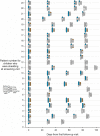CMV on surfaces in homes with young children: results of PCR and viral culture testing
- PMID: 30103693
- PMCID: PMC6088405
- DOI: 10.1186/s12879-018-3318-z
CMV on surfaces in homes with young children: results of PCR and viral culture testing
Abstract
Background: Caring for young children is a known risk factor for cytomegalovirus (CMV) infection mainly through exposure to their saliva and urine. In a previous study, 36 CMV-seropositive children 2 mo. to 4 years old were categorized as CMV shedders (n = 23) or non-shedders (n = 13) based on detection of CMV DNA in their saliva and urine. The current study evaluated the presence of CMV on surfaces in homes of the children.
Methods: Study staff made 4 visits to homes of the 36 enrolled children over 100 days. Saliva was collected by swabbing the mouth and urine was collected on filter paper inserted into diapers. In addition, five surface specimens were collected: three in contact with children's saliva (spoon, child's cheek, washcloth) and two in contact with children's urine (diaper changing table, mother's hand). Samples were tested by PCR and viral culture to quantify the presence of CMV DNA and viable virus.
Results: A total of 654 surface samples from 36 homes were tested; 136 were CMV DNA positive, 122 of which (90%) were in homes of the children shedding CMV (p < 0.001). Saliva-associated samples were more often CMV positive with higher viral loads than urine-associated samples. The higher the CMV viral load of the child in the home, the more home surfaces that were PCR positive (p = 0.01) and viral culture positive (p = 0.05).
Conclusions: The main source for CMV on surfaces in homes was saliva from the child in the home. Higher CMV viral loads shed by children correlated with more viable virus on surfaces which could potentially contribute to viral transmission.
Keywords: Cytomegalovirus; Infectious virus; Transmission; Viral shedding.
Conflict of interest statement
All authors are from the Centers for Disease Control and Prevention (CDC), 1600 Clifton Road NE, Atlanta, GA 30329 (except J. Stowell who recently moved to Emory University but all of her contributions to this work were during her time at CDC).
Ethics approval was obtained from the Centers for Disease Control and Prevention Institutional Review Board B; protocol # 6073.0. Written consent was obtained from all parents or guardians of the children who participated in the study.
Not Applicable.
The authors declare that they have no competing interests.
Springer Nature remains neutral with regard to jurisdictional claims in published maps and institutional affiliations.
Figures




Similar articles
-
Cross-sectional study of cytomegalovirus shedding and immunological markers among seropositive children and their mothers.BMC Infect Dis. 2014 Nov 12;14:568. doi: 10.1186/s12879-014-0568-2. BMC Infect Dis. 2014. PMID: 25388365 Free PMC article.
-
Repeated measures study of weekly and daily cytomegalovirus shedding patterns in saliva and urine of healthy cytomegalovirus-seropositive children.BMC Infect Dis. 2014 Nov 13;14:569. doi: 10.1186/s12879-014-0569-1. BMC Infect Dis. 2014. PMID: 25391640 Free PMC article.
-
Cytomegalovirus Saliva Shedding Kinetics in Children with Congenital CMV Infection.J Pediatric Infect Dis Soc. 2025 May 13;14(5):piaf040. doi: 10.1093/jpids/piaf040. J Pediatric Infect Dis Soc. 2025. PMID: 40319380
-
Review of cytomegalovirus shedding in bodily fluids and relevance to congenital cytomegalovirus infection.Rev Med Virol. 2011 Jul;21(4):240-55. doi: 10.1002/rmv.695. Epub 2011 Jun 15. Rev Med Virol. 2011. PMID: 21674676 Free PMC article. Review.
-
Is it not time for international guidelines to combat congenital cytomegalovirus infection? A review of central nervous system manifestations.Clin Radiol. 2020 Aug;75(8):644.e7-644.e16. doi: 10.1016/j.crad.2020.02.009. Epub 2020 Mar 23. Clin Radiol. 2020. PMID: 32216960 Review.
Cited by
-
Human Nasal Turbinate Tissues in Organ Culture as a Model for Human Cytomegalovirus Infection at the Mucosal Entry Site.J Virol. 2020 Sep 15;94(19):e01258-20. doi: 10.1128/JVI.01258-20. Print 2020 Sep 15. J Virol. 2020. PMID: 32727881 Free PMC article.
-
Pathogenesis of Wild-Type-Like Rhesus Cytomegalovirus Strains following Oral Exposure of Immune-Competent Rhesus Macaques.J Virol. 2022 Feb 9;96(3):e0165321. doi: 10.1128/JVI.01653-21. Epub 2021 Nov 17. J Virol. 2022. PMID: 34788083 Free PMC article.
-
Cytomegalovirus in donors for fecal microbiota transplantation, the phantom menace?PLoS One. 2023 Jun 29;18(6):e0287847. doi: 10.1371/journal.pone.0287847. eCollection 2023. PLoS One. 2023. PMID: 37384665 Free PMC article.
-
Challenging the Conventional Interpretation of HCMV Seronegativity.Microorganisms. 2021 Nov 18;9(11):2382. doi: 10.3390/microorganisms9112382. Microorganisms. 2021. PMID: 34835508 Free PMC article.
-
Prevalence, Magnitude, and Genotype Distribution of Urinary Cytomegalovirus (CMV) Shedding Among CMV-Seropositive Children and Adolescents in the United States.Open Forum Infect Dis. 2019 Jun 5;6(7):ofz272. doi: 10.1093/ofid/ofz272. eCollection 2019 Jul. Open Forum Infect Dis. 2019. PMID: 31281866 Free PMC article.
References
-
- Adler SP. Cytomegalovirus transmission and child day care. AdvPediatrInfectDis. 1992;7:109–122. - PubMed
-
- Grosjean J, Trapes L, Hantz S, Mengelle C, Virey B, Undreiner F, Messager V, Denis F, Marin B, Alain S. Human cytomegalovirus quantification in toddlers saliva from day care centers and emergency unit: a feasibility study. J Clin Virol. 2014;61(3):371–377. doi: 10.1016/j.jcv.2014.07.020. - DOI - PubMed
MeSH terms
Substances
Grants and funding
LinkOut - more resources
Full Text Sources
Other Literature Sources
Medical

